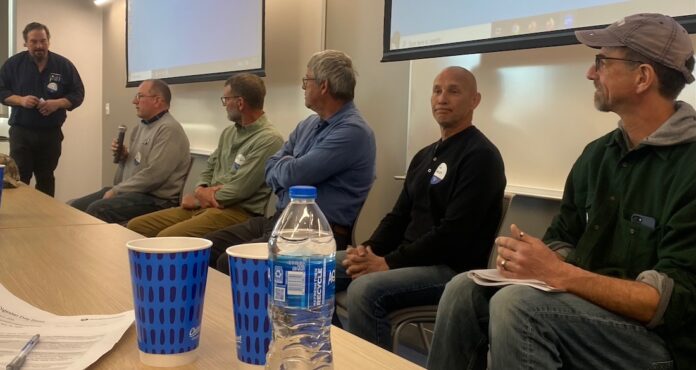
STATE COLLEGE, Pa. — Are you thinking about installing a manure digester?
It might seem like an easy decision to have an on-farm system to harness heat and energy from manure, but there are many things to consider and all are critical to the operations of a digester system, according to panelists who spoke at the Penn State Extension-sponsored Digester Day, held March 19, in State College.
Digester management “is seven days a week,” said panelist Matt Steimann, special projects manager, Dickinson College Farm, Carlisle, Pennsylvania.
Before breaking ground, consult experts from the U.S. Department of Agriculture’s Natural Resources Conservation Service, Penn State and other extension offices and digester operators.
The installation and operations process is costly and can run into the millions of dollars. It is important to set up a plan and talk to manure digester experts before deciding what to do.
The good news: Standardization for manure digester construction may be just around the corner, which could considerably bring down the costs of installation and operations.
The science
Digester science involves having a supply of manure that can be covered for fermentation, and a method to burn off the resulting methane gases cleanly or use the gases to generate power.
According to Penn State, producing methane (valued for its use as a fuel) by anaerobic digestion of agricultural organic residues, especially animal manure, is feasible.
Renewed attention is being directed to biogas generation as a source of fuel in the U.S. Although research has been directed primarily to the waste-treatment potential of anaerobic fermentation, turning manure into compost, rather than to energy recovery.
Some advantages of anaerobic digestion include: Organic content of the residue is reduced and stabilized so that final disposal presents a reduced pollution problem; digested residue is an almost odorless, free-flowing liquid; fertilizing nutrients are conserved, and methane has significant value as fuel.
Some disadvantages are: Equipment is complex and involves a high initial investment; daily feeding of digesters at controlled loading rates is desirable; energy input is required; high standards of maintenance and management are required, and strict explosion-proof standards must be maintained.
Challenges
The Dickinson digester, with an output of 48 kilowatts per hour with a combined heat and power engine, is in its first year of operation at the farm. It’s fed by manure collected from the farm’s 150 dairy cows and heifers from a local dairy farm. Also included are food waste materials from cafeterias, restaurants and orchard apple crop waste. The digester feeds every four hours, Steimann said, and the farm uses a webcam to keep an eye on the operation.
Dickinson Farm power is being generated for heating but is not yet part of the Met-Ed electrical grid. Steimann said that technology may allow operators to collect gas for commercial kitchen use via compression tank rigs.
The biggest challenge for some digester managers “is just getting the manure there,” said Keith Spicher, who, along with brother Kent, runs Kish-View Farms in Belleville, Pennsylvania.
Its 600-cow herd is across the street from a 500-resident retirement community. The digester has been lauded for its “odor reduction and as a social license to farm, in good community standing,” according to Keith Spicher.
It was installed in 2010 and went into operation in 2011. So far, the digester has allowed them to generate their own electric power.
Tech upgrades
The new technology that runs modern systems can be both a blessing and a curse.
The Schrack Farms’ digester, in Loganton, Pennsylvania, has been operating since 2006, one of the oldest in the state. The digester is fed from the farms’ 1,300-cow dairy and also makes use of food grease-trap waste.
A $400,000 upgrade will be in place early this year, said Jim Harbach, of Schrack Farms. The output goal is 200 kilowatts per hour (kWh) at 90% efficiency. The highest check for generating energy from a digester amounted to $100,000 from PPL, Harbarch said.
The new system is so “techy,” Harbach said. “The tech is tremendous.” He believes that producers are “missing the boat” if they collect the electricity but ignore the heat it can produce for their operations.
When the technology is working, everything runs smoothly, said Rich Walters, operations manager, Reinford Farm, Mifflintown, Pennsylvania. Reinford Farm milks 650 cows and its manure digester is used to generate electricity.
The challenge comes “when you have to bring somebody else in to fix it after midnight,” Walters said. “Fixing the tech can be a problem.”
Costs
Installing a digester does not happen overnight. Tim Rensch, of Nutrient Control Systems Inc., Chambersburg, Pennsylvania, said that a good rule of thumb is that a digester startup can take three to four years until it is up and running.
If you want to install digesters, “come to us to see where they fit into a plan,” said Tim Peters, Pennsylvania Natural Resource Conservation Service. The NRCS can advise on a system and work up a report.
Luca Siguro, Gruppo, a renewable natural gas manufacturing company headquartered in New York City, noted the importance of “sizing the digester to the farmer.” Some operations can be simply too small. Generally, the larger the dairy or other operation, the better.
Siguro said there are “thousands of digesters in Europe.” It is important for the European operations to add food waste. The supply chains and standardizations will help reduce the cost, eventually, in the U.S.
Will Charlton, president of Digester Doc, in Boise, Idaho, said digester efficiencies will increase in the next five years and artificial intelligence systems will have a large impact on the industry.
Randy Swope, of the Penn State University Farm facilities, provided a tour of Penn State’s 233,000-gallon digester and associated equipment to those attending the Digester Day. The dairy farm location houses a 120 kWh system that broke ground in 2018 and will be brought online soon. The system uses a sand bedding separator. The dairy manages manure from 240 milking cows and replacement stock.









